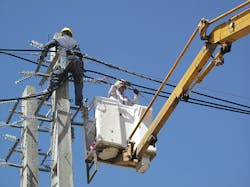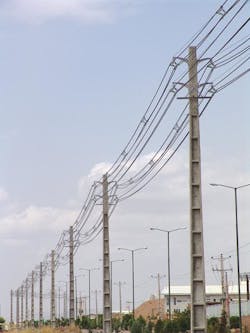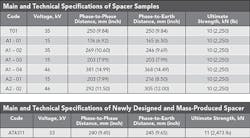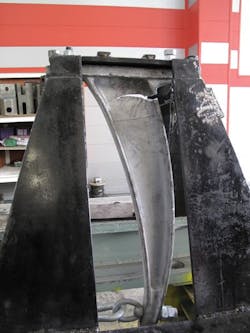Iran Uses Spacer Cable
Dramatic growth in a foreign investment industrial zone (FIIZ) in Iran resulted in an urgent need in 2009 to provide 36 MW of demand with high reliability. East Azerbaijan Electricity Distribution Co. (EZEDC) supplies the region near Tabriz, Iran, which encompasses 55 active industries with almost 4,500 employees. The Iranian utility was aware of the advantages medium-voltage (MV) overhead spacer cable offers in terms of high reliability, a narrow right-of-way corridor and high load-transfer capability, all high-priority considerations for the utility. However, at the time, there was no experience in the country in the design, commissioning, operation, maintenance and production of spacer cable overhead lines.
Spacer Cable Development
One of the leading distribution utilities in research and innovation in Iran, EZEDC launched a research project with the support of the University of Tabriz to gather all necessary information for the installation of a four-circuit-per-pole MV spacer cable to supply the FIIZ. Within a year, the research project was successfully finished, providing the necessary knowledge for EZEDC to be in a position to build circuits.
The use of covered and insulated conductors for overhead distribution lines started in Iran in 2005 following successful research cooperation between the University of Tabriz and EZEDC, which resulted in mass production of MV covered conductors. In 2006, the first insulated messenger wire system, low-voltage (LV) aerial-bundled cable was manufactured in Iran in accordance with the European HD 626 standard.
Spacer Cable Research Project
In 2009, the University of Tabriz started a research project with financial support from the Iranian power generation and transmission and distribution utility, Tavanir, to develop standards for the use of covered conductors, aerial-bundled cable and space cable on overhead distribution lines. The first national standards were released in 2011, whereby technical specifications were developed for conductors, fittings, accessories, installation equipment and installation methods. Test procedures are also now available for MV covered conductors, MV aerial-bundled cable, LV aerial-bundled cable and MV spacer cable overhead distribution lines.
The research project also included a draft revision on right-of-way rules for overhead distribution lines. Currently in Iran, there is wide-scale construction of MV and LV overhead distribution lines strung with covered conductors and aerial-bundled cable.
Space Cable Distribution Lines
The spacer cable overhead electrical distribution line, comprised of a messenger wire supported system of covered conductors in a closed triangular/delta configuration, has some advantages compared with covered conductors:
- The possibility to use all-aluminum conductors (AACs) instead of aluminum alloy conductors (AAACs)
- No requirement for additional protection equipment against lightning and the use of porcelain insulators on suspension poles
- Reduction in the width of the right-of-way corridor, simplified installation and the possibility of installing more than one circuit on the overhead line supports (wood poles)
- The opportunity to install longer spans
- A lower voltage drop, balanced phase impedance, higher capacitance and lower inductance.
- Also, compared with MV aerial-bundled cable overhead distribution lines, the use of spacer cable offers the following advantages:
- Simpler troubleshooting or fault finding as the aerial-bundled cable is wrapped around the messenger wire
- Lower initial cost
- Easier tee-off and connection to pole-mounted transformers.
Design Features
The spacer cable configuration mainly consists of three separate three-layer covered conductors hanging from a messenger wire using a number of spacers in each span. It is necessary to use stranded Alumoweld, aluminum-clad steel core wire, or a steel messenger wire in addition to spacers because the conductor comprises three-layer aluminum covered conductors. The rated tensile strength (RTS) of the aluminum conductor is insufficient to support the conductors in long spans. Therefore, it is necessary to compute the exact distance between spacers in each span by considering the RTS of a three-layer covered conductor. In practice, this results in the three-layer covered conductors hanging from spacers positioned some 10 m (33 ft) apart.
The messenger wire supports the total mechanical load of the network, namely the covered conductors, spacer’s weight, wind and ice loading. The messenger wire is supported by brackets bolted to the poles, this being one of the main attractive features of spacer cables; therefore, it is possible to design the mechanical and electrical characteristics independently. For example, to determine the specifications of messenger wire for a wide river crossing, it is sufficient enough to know the span length between the poles on either side of the river. Then, by considering all horizontal and vertical loads on covered conductors, messenger wire and spacers, RTS of messenger wire and a suitable safety factor, it is easy to select the characteristics for a suitable messenger. The pole-mounted brackets required to support the messenger wire may be made of galvanized steel or aluminum alloy, but the installation procedures of spacer cable make it necessary to use some specially designed components.
The conductor, which is stranded and compacted AAC, is surrounded by a semiconductor layer that dissipates the electrical stresses. Also, cross-linked polyethylene (XLPE) is the first insulation layer around the semiconductor. The outer insulation layer consists of black high-density polyethylene (HDPE). The spacers are made of HDPE and may have different shapes such as lozenge, cross and vertical three-phase form.
Pilot Space Cable Project Design
The spacer cable pilot project selected by EZEDC was the erection of a 20-kV overhead line, 650 m (2,133 ft) in length, to supply a load of 36 MW in Tabriz. This industrial town has a high electrical demand and considerable air pollution attributable to a large cement factory. The design features for this 20-kV four-circuit overhead line were considered in four categories: electrical, mechanical, fittings, and tools and spacer production
To supply the 36-MW demand for the FIIZ, EZEDC selected the technical specifications of a 150-sq-mm (0.23-sq-inch) AAC, the standard used by a utility in the western U.S. This conductor has a current-carrying capacity of 389 A, with a maximum conductor temperature of 75°C (167°F) in an ambient temperature of 25°C (77°F) and a wind speed of 0.61 m/sec (2 ft/sec). This conductor is capable of supplying the 36-MW demand with some 33% surplus capacity available to supply any future increase in demand by the FIIZ. The three-layer covered conductor designed and made in Iran with semiconductor XLPE and HDPE layers successfully passed the specified tests.
A software program was developed for the mechanical design to calculate the sag-span characteristic of messenger wire before and after installation of spacers and covered conductors. These calculations are based on loading conditions, high winds, ice accretion, everyday stress, and minimum and maximum temperatures. These calculations determined the worst sag and tension conditions. The messenger wire is pre-stressed in the installation stage, so the sag is acceptable after installation of covered conductors and spacers under the worst loading conditions.
Fittings and Tools
Some fittings, accessories and tools have to be designed and fabricated prior to installation of the spacer cable. A main part of the spacer cable configuration is the brackets. It is possible to make brackets from aluminum alloy or galvanized steel. The aluminum-alloy brackets are lighter, in a more aesthetic shape and easier for mass production. After mechanical analysis by Abaqus software, the research group determined the suitable material to withstand the necessary loading conditions. In addition to brackets, it was necessary to design and produce other accessories such as installation tools, dead-end helix-forms and spacers.
To design and manufacture the lozenge-shaped spacers, EZEDC analyzed all publicly available information from Hendrix Co. as well as some spacers manufactured in Thailand. A new lozenge-shaped spacer was designed, analyzed, tested and mass produced for the 20-kV overhead lines.
There is considerable experience in Iran on the design of traditional overhead line insulators, which helped to create the new ultraviolet-resistant HDPE spacer. It passed the tensile tests according to IEC 61284. The comprehensive electrical testing program conducted under specified laboratory temperature and pressure conditions were modeled by the SGE-400kV-20MJ Haefely Trench Co. test system. The power frequency wet discharge and withstand voltage tests were conducted according to IEC 60060-1 (2010). The comprehensive testing regime did not produce any visible breakdown of sample spacers.
Since commissioning the 20-kV four-circuit overhead lines, there have been no forced power outages.
Applications in Progress
The success of this development project was a result of the close collaboration between EZEDC’s engineering team and the University of Tabriz. Following the successful commissioning of the pilot installation project, the University of Tabriz was selected to develop national standards for MV spacer cable overhead lines. Three standard volumes were completed, including all necessary installation drawings, designing tables, and installation and maintenance of spacer cable overhead lines. EZEDC has implemented four new MV spacer cable projects in the region and is ready to commission new national and international spacer cable projects.
Overhead distribution lines using spacer cable are already being used in Iran. And as an extension to the development work already undertaken, the industry and university cooperation team plan to start developing 63-kV spacer cable overhead lines in the near future.
Karim Roshan Milani ([email protected]) has served as the associate principal of deputy of engineering at East Azerbaijan Electricity Distribution Co. since 2010. Prior to that, he was manager of the planning department from 1994-2010. He also is a research and development consultant for the wire and cable producers of aluminum conductor steel-reinforced conductors in Iran. Milani is co-manager of the project on Iran’s national standard for covered and insulated overhead distribution lines and their right-of-way rules. He has authored numerous books on overhead lines and is a co-operator of extensive research as well as a member of the Committee on Conductors and Cables for Tavanir, Iran.
Mehrdad Tarafdar Hagh ([email protected]) has been with the faculty of electrical and computer engineering at the University of Tabriz since 2000, where he is currently a professor. He has published more than 220 papers in power system engineering and fulfilled 21 industrial-related research projects. Hagh introduced the medium-voltage spacer cable system in Iran and was manager of the first medium-voltage spacer cable overhead distribution line research project in Iran. As a research and development consultant for some wire and cable producers in Iran, he is co-manager of the project on Iran’s national standard for covered and insulated overhead distribution lines and their right-of-way rules. Hagh is member of the Committee on Conductors and Cables for Tavanir, Iran.
Editor’s note: In the July 2015 issue of Transmission & Distribution World, the article entitled “Iran Uses Spacer Cable” reported that Iranian utility companies (“EZEDC”) had reviewed spacer cable information from a company identified as Hendrix Co. We have revised the article to clarify that the information reviewed by EZEDC was publicly available information from various sources. The EZEDC did not obtain any information about spacer cable systems or related technology from Hendrix Wire and Cable, Inc. Hendrix Wire and Cable Inc. has not supplied any products, images or critical design information to Iran. Hendrix Wire and Cable Inc. operates in full compliance with U.S. law, does not do business with Iran, and has not supplied spacer cable or related technology to Iran.




